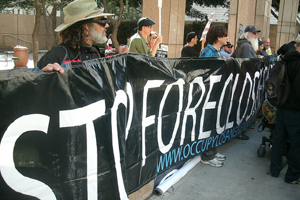Getting Members Involved in Occupy’s Next Phase

Every steward in North America must have members who are talking about the Occupy movement. Maybe your union has endorsed Occupy officially. Perhaps you have participated in some Occupy action yourself.
Certainly the rapid spread of the movement made many union members optimistic in a way that we haven’t been for a long time. The idea that the 99% can actually stand up to the 1% is contagious.
How can stewards build on this moment of opportunity to strengthen the union? After all, the issues Occupy has been raising—economic inequality, thievery by the banks, failure of the corporations and rich to pay their share in taxes, increasing unemployment and insecure employment—are the same issues the unions have always fought.
As the encampments have mostly been destroyed across the country, the movement has morphed into thousands of actions pursuing the same general goals. Some places are focusing on protecting residents from foreclosure and evictions, some are holding actions at banks, and some, like Occupy Education or Occupy Post Office, take the Occupy idea back to where people work or need services.
Today will see actions and arrests in Los Angeles, New York, Portland, and elsewhere as Occupiers blockade Bank of America and others, calling it a day to "shut down the corporations."
STOPPING FORECLOSURES
In Detroit, a big United Auto Workers local has been sending officers and staffers to help stop foreclosures, in actions carried out by Occupy and other local groups. “We’re looking to collaborate with anyone working for social justice,” says Local 600 President Bernie Ricke.
The coalitions have stopped two home foreclosures and one of a popular theater that is Occupy’s meeting place.
In the most dramatic action, the protesters used cars to block the street near a family’s targeted home. A simultaneous delegation to the foreclosing bank resulted in a back-down: the family will be allowed to buy their home for $12,000.
Asked if some members resented the union’s working on behalf of non-members, Ricke said, “We can do both. We have a moral responsibility to help people in our community. On the foreclosure issue, there might be a disconnect for people who have their house paid off or aren’t underwater, but we just say to them, ‘what have all these foreclosures done to the value of your home?’ They can see that it does affect them.”
Longshore and Warehouse (ILWU) Locals 6, 10, and 13 in California are exploring a program to mobilize their members for community fights.
They’re looking to emulate the Service Employees. In the ’90s, SEIU locals used their hiring hall dispatcher (who gives out job assignments) to put the word out to members that the hiring hall would be held that day at a site where janitors were picketing.

SUPPORT LABOR NOTES
BECOME A MONTHLY DONOR
Give $10 a month or more and get our "Fight the Boss, Build the Union" T-shirt.
“Those that didn’t get called on for work right away would have the option to join the picket line, and most did,” said the ILWU’s Peter Olney. “It sure beat the hell out of sitting at the hiring hall playing cards, and it was a great way to build up a culture of solidarity amongst members.”
Now the focus is on home defense. Occupy Long Beach hosted a workshop on foreclosures, with ILWU members in attendance, and member participation in actions against home foreclosures in San Francisco and East Oakland has been slowly growing. The key is linking it to challenges facing members’ families, Olney said.
Union members in Minneapolis, including activists from AFSCME Local 3800 (university clerical workers) and SEIU Local 26 (building service workers) have participated in several Occupy actions defending homeowners as well.
In November they were successful in keeping Monique White, a North Minneapolis resident, in her home. Now White has opened her home as a base for neighborhood organizing. Two dozen volunteers conduct regular neighborhood canvassing to generate support for White to stay in her home, and to identify and recruit additional homeowners in foreclosure willing to work with occupiers to fight back.
“Unions here have walked the line pretty well between supporting Occupy and not trying to co-opt it,” said Nick Espinosa, an activist with Occupy Minnesota.
CULTURE CLASH
Occupy, with its “mic checks” and general assemblies, is culturally a long way from a typical union demonstration where everyone wears the same color T-shirts and leaders speak from a stage.
But the fact that the two cultures are supporting each other is something to celebrate. It’s very different from what happened in the anti-Vietnam war movement or even the civil rights movement.
Head to your local Occupy general assembly yourself and see what’s happening. Occupiers may be activists, but that doesn’t mean they know more than the average American about unions and how the labor movement works. You can have some interesting conversations. Come back and talk about what you see, good and bad.
The exercise of political speech at work, including posting things on bulletin boards, wearing 99% stickers, and encouraging participation in the actions raised by Occupy can both educate members and engage them in the messy optimism of the movement, substituting courage for fear and banking solidarity for the future.
Joe Berry and Helena Worthen are retired labor educators.




